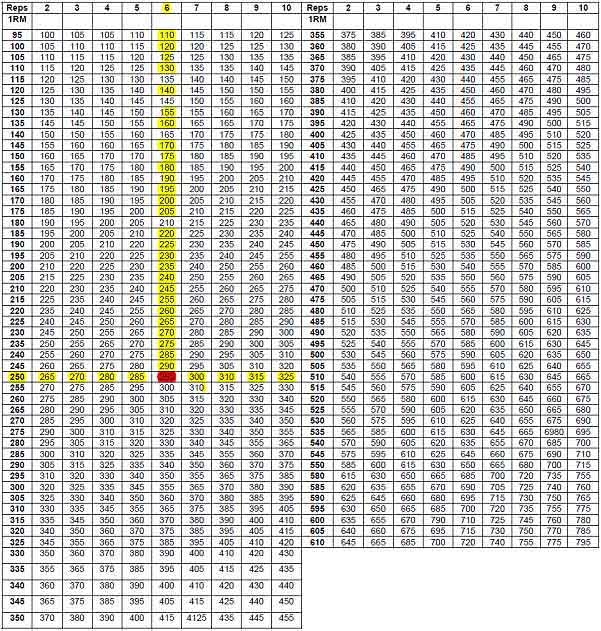Your 1-Rep Max Testing Made Simple
December 8, 2015
A generic warm-up and a few arm swings aren’t enough to make the most out of your training. In fact, if you’re looking to build athletic muscle and strength, then you’ll need a specific warm-up that leads up to crushing your 1-Rep Max (1RM).
Establishing a 1-Rep Max has a plethora of benefits, such as allowing you to track progress over time, and use appropriate loads on all exercises to hit your goals.
Still, there is much confusion surround max lifts.
- How many warm-up sets?
- How long do I rest between sets?
- Are you sure there’s not a direct correlation between my manhood and my max?
- How much weight should I use for each warm-up set?
When it comes down to your training numbers and mores specifically, maxes…
“If you ain’t Assessing, then you’re Guessing”
And it’s true. If you don’t know how strong you are, how can you really dictate what 60-85% of 1-RM is for hypertrophy work?
Or how can you determine 90% to for the heavy singles in your strength cycle?
Even more, if you don’t know how strong you are, how will you know if you’ve gotten stronger and made progress in the gym?
That’s where max-testing comes in: Determining your progress in the gym and providing a tangible number to base your future weights off of.
With that in mind, I’m going help you optimally prepare for your max, managing fatigue in the warm-up while stimulating your body to crush a new P.R., so you can make huge progress and drink copious amounts of protein.
How to Warm Up for a One-Rep Max
Warming up to test your max varies for each person. Some people can blast a huge personal record (PR) right in the middle of a workout whereas some need a process that’s refined to every last detail.
That said if you’ve walked into the gym with the goal of establishing a new PR and found yourself missing lifts, the culprit is more often than not, your warm-up.
You either did too little or too much, burning out your central nervous system (CNS) before really getting a chance to set a personal record.
The General Dynamic Warm-Up
A solid warm-up lubricates your joints, tissues, and tendons while elevating your core temperature, priming your body to develop force and optimize training.
Furthermore, a warm-up prepares you for the mental battle ahead. Intense training requires intense focus to maximize results– stay off your phone, and visualize the task at hand.
Sample Dynamic Warm-Up
This combination of exercises will activate deep and superficial trunk stabilizers to protect your spine and optimize the transfer of force. Further, these exercises will activate muscle tissues while simultaneously increasing mobility and stability through the hip, knee, ankle, and shoulder.
Quadruped Fire Hydrant x6
Quadruped hip extension x6
Floor slide x6
Hip Thrust x6
Inchworm x6
T-Push-Up x6
Jumping Jacks x50
Lateral Squat x6/each
Front Lunge x6/side
Slow Mountain Climber x10/side
Groiner x5 side
Once you’ve completed the general warm-up, it’s time to prepare your body for the max-out lift. While lunges are great to warm-up the hip, knee, and ankle, if you’re testing a clean or squat, then please, go do some cleans or squats. This directly ramps your neuromuscular system and grooves technique for maximum results.
The Math 1-Rep Max Testing
Mathletes, I’m here for you. While you don’t need a number to start your testing, you need to have a ballpark idea of your strength numbers.
For the quick and easy way, use this calculator from Bodybuilding.com. Or, get a “guestimation,” look at the corresponding chart to get an estimated 1-Rep Max
Ex.) On the chart below, you did 170 lbs. for six reps. Therefore, your estimated 1-RM is 200 lbs.

(“One Rep Max Calculators “)
1-Rep Max Conversion Equations
Baechle equation
- 1-Rep Max = Weight × (1 + (0.033 × number of repetition))
Brzycki’s equation
- 1-Rep Max = Weight ÷ (1.0278 – (0.0278 × number of repetitions))
O’Conner’s formula
- 1-Rep Max = weight × (1 + 0.025 × number of repetitions)
Fun, right?
Testing Your 1-RM (headline)
The basic outline of the 1-RM starts very light, with the first 3-4 sets being easy. The biggest mistake most lifters do is ignore their rest.
Unless you want to bust your shit like Timothy below, DO NOT DO THIS.
Always rest longer and air on the side of caution when it comes to testing a max. Although you might feel fresh, your CNS requires more time to fully recover for massive #gains than your cardiovascular and muscular system.
This approach gradually stimulates the neuromuscular system to warm-up and achieve optimal performance in training.
| Set Number | %-1RM | Reps | Rest after Set |
| 1 | 40-50% | 8 | 60-90 seconds |
| 2 | 60% | 4 | 60-90 seconds |
| 3 | 70% | 2 | 90-120 seconds |
| 4 | 80% | 1 | 3-5 minutes |
| 5 | 90% | 1 | 3-5 minutes |
| 6 Max Out 1 | 95-100% | 1 | 5-7 minutes |
| 7-10 (max) | 100+, 2-5% increase each | 1 | 5-7 minutes |
Once you get to the sixth set, the first max out, rest periods go way up. Some coaches call for as much as 10-15 minutes, but highly advanced competitive lifters aside, 5-7 minutes is fine for intermediate lifters.
Sample Warm-Ups by Estimated 1-Rep Max
Here are some sample warm-up routines based on estimated 1-RM. If you have a ballpark guess on your numbers, these protocols will provide some structure for your testing.
Estimated 1-Rep Max: 105 lbs.
45×8
60×4
75×2
85×1
95×1
105×1
110-115+ x1
Estimated 1-Rep Max: 135 lbs.
65×8
85×4
95×1
105×1
115×1
125×1
135+x1
Estimated 1-Rep Max: 185 lbs.
95×8
115×4
135×2
155×1
170×1
185×1
185+x1
Estimated 1-Rep Max: 225 lbs.
135×8
155×4
180×2
195×1
205×1
215×1
225+x1
Estimated 1-Rep Max: 275 lbs.
135×8
185×4
205×2
225×1
245×1
260×1
275+x1
Estimated 1-Rep Max: 315 lbs.
135×8
185×4
205×2
235×1
255×1
275×1
285+x1
315+x1
Estimated 1-Rep Max: 365 lbs.
135×8
185×4
215×2
245×1
285×1
325×1
365+x1
1-Rep Max Final Guidelines
- Use easily calculated numbers like 135, 185 etc. on your beginning warm-up sets. This minimizes the number of plates on the bar and keeps transitions and calculations as easy as possible.
- Keep low-rep sets low rep. Once you get into 1-2 rep sets, keep the reps there. Repeat early sets if needed, but the point is to avoid fatigue with volume while maximally stimulating the CNS.
- If you remember anything from this post, be conservative with your rest periods when lifting heavy.
- For max sets, add 5-10 pounds of upper body lifts, and 10-15 on lower body lifts when making further attempts at a max.
- After your third warm-up set, always use a spotter. For safety, this is a no-brainer. For performance, your spotter will help you refine flaws in technique, and correct them before loading ultra-heavy weights.
The goal behind finding and using a 1-Rep Max is to measure and track your performance. This might seem like a lot of work, but trust me: It’s worth it. Not only will you get a huge confidence boost, but you’ll also build a structure for all your workouts going forward.
Get strong, do it safely, and optimize your high-performance training.
Want to build a strong, muscular, and athletic body in less than 45 minutes per workout?
If so, grab the ultimate muscle-building workout for busy professionals, The Minimalist Muscle Blitz









[…] Your 1-Rep Max Made Simple — Eric Bach […]
[…] 2. Your 1-Rep Max Made Simple by Eric Bach […]
[…] Your 1-Rep Max Made Simple – Bach Performance […]
[…] since the DUP treatment group had a significantly higher baseline 1RM it can be suggested that the DUP treatment group did elicit a greater change in maximum strength, […]